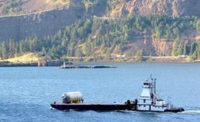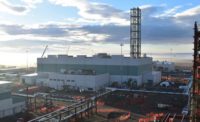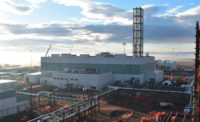Nearly two decades after design and construction began on what became a $17-billion multi-part facility set to treat millions of gallons of nuclear waste stored in below-ground tanks at the U.S. Dept. of Energy Hanford former weapons site in eastern Washington, work has largely finished on one facility to treat the least contaminated but largest volume of site wastes to meet a cleanup deadline.
The construction completion by Bechtel National moves a key part of the Tank Waste Treatment and Immobilization Plant into the startup phase, with the next step permanently firing the first of two 300-ton melters by the end of 2021 in a “vitrification” process that will turn nuclear and chemical wastes into glass logs for permanent onsite burial.
“Hanford is on the precipice of actual tank waste treatment," said Mark Menezes, DOE deputy secretary, at a Jan. 6 virtual event held inside the facility to mark construction completion.
The construction completion of this first facility in the treatment complex comes as DOE confirms a decision to cancel its $13-billion site waste management contract award to a BWXT-Fluor team, in order to combine treatment plant operations management into its scope and re-procure the enlarged contract.
Long Haul
DOE says the new Low Activity Waste facility (LAW) has a target of treating 90% of 56 million gallons of the site’s buried radioactive waste by the end of 2023—a deadline set five years ago under a state and federal consent decree that dates to 1989.
Along with the LAW plant, the Bechtel team also completed an analytical lab to insure glass log quality, an effluent waste facility to treat plant-generated waste and 14 other process support structures. About 50% of the effluent facility systems have completed startup testing and the lab and all 14 support structures have done so to ensure process systems integrate and are ready for operations.
A federal court judge in December agreed to extend the 2023 deadline by several month because of site work impacts from COVID-19. DOE restricted the site workforce to about 10% of the total on March 23, with workers returning in phases since then.
Brian Vance, a DOE Hanford site manager, said crews still met the consent decree deadline on construction and believe they can reach “hot commissioning” in 2023 without needing the additional time.
'Critical Step'
In recent years, DOE has focused on treating the low level waste, shifting attention and resources from initial plans to also treat and dispose of highly-contaminated waste, because of major technical glitches in design of that treatment process.
DOE also is developing a system to separate the low-level and high-level waste streams from 177 storage tanks and pump the former into the now completed treatment plant in 9,000-gal batches.
In late 2020, Bechtel and tank farm contractor Washington River Protection Solutions successfully tested 7,000 ft of piping that will move condensate produced during vitrification to a liquid effluent retention facility. The transfer lines to move pretreated waste from underground tanks to the LAW facility are “being installed,” according to a DOE update.
Hanford officials did not respond yet to an ENR query for further detail on the scope and status of the waste separation and pumping infrastructure.
Valerie McCain, Bechtel plant project director and a senior vice president, said starting the first melter—which will heat waste materials to 2,100° F to form glass for long-term safe storage—“is the first critical step in our commissioning process.”
She noted that system testing, procedures and training must still be established.
The construction of what is said to be the world's largest plant to treat radioactive waste "is truly a scientific and engineering feat," said Sen. Maria Cantwell. (D-Wash). She and Sen. Patty Murry (D-Wash.) vowed to continue to fight for federal resources to ensure the ongoing cleanup at the 560-sq-mile Hanford site.
Hot Stuff
The new treatment plant is a 330-ft-long, 240-ft-wide and 90-ft-high concrete structure designed to mix waste with silica and other glass-forming materials before it reaches the two melters
At about 20 ft by 30 ft and 16 ft tall, the world's largest waste glass melters will create vitrified glass resting in containers 7-ft-long and 4-ft-dia, weighing more than 7 tons each.
During plant operations, the two melters will produce 30 tons of glass daily, ten times the capacity of the melter in operation at DOE's Savannah River Site in South Carolina.
DOE still does not have a final plan for finishing design or construction of Hanford's high-level waste treatment.
Tom Carpenter, executive director of leading site watchdog group Hanford Challenge, supports the vitrification process, but has concerns about unresolved technical issues that he believes will delay treatment of both waste categories.
Dan McDonald, state Dept. of Ecology tank waste disposal project manager, said while the new treatment facility is far-reaching, much is yet to be accomplished. Still, the state “anticipates the startup to go smoothly and looks forward to seeing the plant in operation, on time, as planned.”






Post a comment to this article
Report Abusive Comment